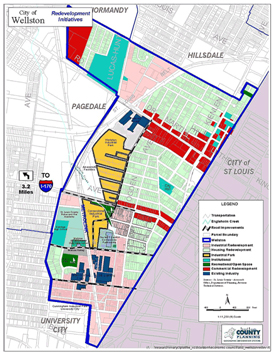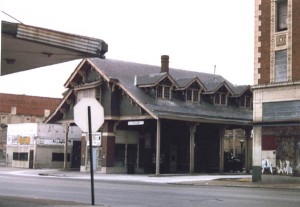To Incorporate – or Not to Incorporate: The Question That Divided a Community
By the early twentieth century, Wellston was a booming town. Not surprisingly, the residents of that area felt they deserved a city government of some sort, and the question of incorporation surfaced.
A petition to incorporate Wellston was submitted to the St. Louis County Court, which granted Wellston a charter as a city of the third class on June 26, 1909. However, anti-incorporationists took the matter to court. A special commissioner, J.C. Hargis, was appointed by the state supreme court to resolve the case. He found that Wellston was not legally incorporated and revoked the charter on March 21, 1911. During the year-and-a-half or so that Wellston believed it was a city, three men served as mayor: Roy C. Woods, Dr. Irl R. Hicks, and Charles J. Roberts.

municipal boundaries for the portion of Wellston located in St. Louis County (St. Louis County Economic Council)
By the 1940s, Wellston was still an unincorporated neighborhood and still had ambiguous boundaries. According to J.B. Day, president of the Wellston Chamber of Commerce and unofficial mayor of Wellston, the community was bounded by the following lines: west to Hanley Road, east to Goodfellow Avenue, north to Natural Bridge Road, and south to Olive Street Road. Consequently, part of the Wellston community was within the St. Louis city limits and part located in unincorporated St. Louis County.
By the late 1940s, incorporation had again become an issue. At first glance, it may seem that such a move was unwise. By incorporating the community, Wellston was forced to limit its population to less than 10,000. However, University City was discussing – and making proposals – to annex the Wellston area.
When the residents decided to incorporate Wellston as a third-class city in June, 1949, the community had close to 9600 residents. Leo J. Hayes was elected mayor in 1950 and served well into the late 1960s.
Hayes, a dentist, met with a lot of opposition during his political career. Wellston had had a reputation as “the fortune-telling and mind-reading center of the Midwest. A few of the swamis are in Wellston still, but not nearly as many. Further, Wellston is a fairly prosperous community. Many residents work for the big industries. There is a lot of spending money in circulation. Given a chance, gambling might really flourish in Wellston.”
The anti-Hayes group felt they were the ones who should put an end to all this. As his long term as mayor proves, his opponents were unsuccessful in unseating Hayes.
Next.
